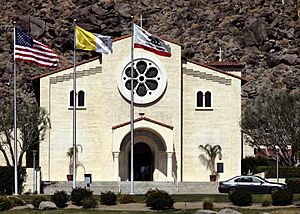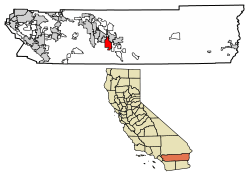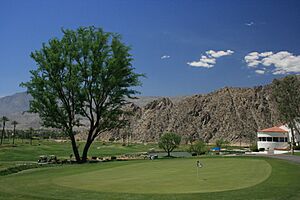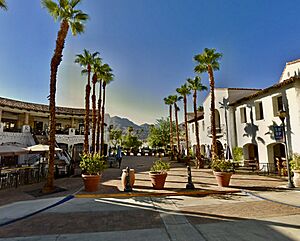La Quinta, California facts for kids
Quick facts for kids
La Quinta, California
|
|||
|---|---|---|---|

St. Francis of Assisi Church
|
|||
|
|||
| Motto(s):
The Gem of the Desert
|
|||

Location of La Quinta in Riverside County, California.
|
|||
| Country | United States | ||
| State | California | ||
| County | Riverside | ||
| Incorporated | May 1, 1982 | ||
| Government | |||
| • Type | Council–manager | ||
| Area | |||
| • Total | 35.68 sq mi (92.42 km2) | ||
| • Land | 35.26 sq mi (91.32 km2) | ||
| • Water | 0.42 sq mi (1.10 km2) 1.22% | ||
| Elevation | 135 ft (41 m) | ||
| Population
(2020)
|
|||
| • Total | 37,558 | ||
| • Estimate
(2021)
|
41,748 | ||
| • Density | 1,184.07/sq mi (457.17/km2) | ||
| Time zone | UTC-8 (Pacific) | ||
| • Summer (DST) | UTC-7 (PDT) | ||
| ZIP code |
92253
|
||
| Area code | 442/760 | ||
| FIPS code | 06-40354 | ||
| GNIS feature IDs | 1660870, 2411582 | ||
La Quinta is a desert resort city in Riverside County, California, United States. Its name comes from a Spanish phrase meaning "the country villa."
La Quinta is located in the Coachella Valley, between the cities of Indian Wells and Indio. It is known for its many beautiful golf courses. One famous spot is the La Quinta Resort and Club, which opened in 1926. A long time ago, director Frank Capra wrote the movie script for Lost Horizon there.
Contents
Discovering La Quinta's Past
The first people to live in the La Quinta area were the Cahuilla Indians.
In 1926, a man named Walter Morgan built the La Quinta Resort. It was a secret getaway for famous people from Hollywood. This resort also had the first golf course in the Coachella Valley. Roads like State Route 111 were built in the 1930s, making it easier to reach.
As other desert cities became full, La Quinta started to grow very fast in the 1980s. It officially became a city in Riverside County in 1982. In 1980, about 4,200 people lived there. By 1990, the population had grown to 11,215. At first, many people only lived there part-time.
La Quinta's Location and Landscape
La Quinta is about 35.6 square miles (92.4 square kilometers) in size. Most of this area is land, with a small part being water. The city is located on the flat floor of the Coachella Valley. It is surrounded on three sides by the Santa Rosa Mountains.
Long ago, the area was covered by the Pacific Ocean. Over time, dirt and sand from the Colorado River filled the basin, cutting it off from the ocean. About 500 years ago, the Colorado River changed its path. This caused the eastern Coachella Valley to flood, creating a freshwater lake called Lake Cahuilla.
Weather in La Quinta
The mountains around the Coachella Valley affect its weather. They help create a warm climate all year, with some of the warmest winters in the western United States. La Quinta has warm winters and very hot summers.
The average high temperature for the year is about 89.5°F (31.9°C). Summer highs often go above 108°F (42°C) and can even reach over 120°F (49°C). Summer nights usually stay above 82°F (28°C). Winters are warm, with daytime highs often between 68°F and 86°F (20°C and 30°C).
La Quinta gets less than 4 inches (100 mm) of rain each year. It enjoys over 348 sunny days annually. The hottest temperature ever recorded was 125°F (52°C) on July 6, 1905.
| Climate data for La Quinta, California, elev. 10 feet (3.0 m) (1981–2010) | |||||||||||||
|---|---|---|---|---|---|---|---|---|---|---|---|---|---|
| Month | Jan | Feb | Mar | Apr | May | Jun | Jul | Aug | Sep | Oct | Nov | Dec | Year |
| Record high °F (°C) | 97 (36) |
100 (38) |
103 (39) |
109 (43) |
117 (47) |
123 (51) |
125 (52) |
121 (49) |
122 (50) |
115 (46) |
101 (38) |
93 (34) |
125 (52) |
| Mean daily maximum °F (°C) | 72.0 (22.2) |
75.3 (24.1) |
81.3 (27.4) |
87.5 (30.8) |
95.7 (35.4) |
103.1 (39.5) |
107.3 (41.8) |
106.6 (41.4) |
102.0 (38.9) |
91.9 (33.3) |
79.6 (26.4) |
71.0 (21.7) |
89.5 (31.9) |
| Daily mean °F (°C) | 58.3 (14.6) |
61.6 (16.4) |
68.1 (20.1) |
74.1 (23.4) |
81.7 (27.6) |
88.6 (31.4) |
93.8 (34.3) |
93.4 (34.1) |
88.0 (31.1) |
77.8 (25.4) |
65.7 (18.7) |
57.6 (14.2) |
75.8 (24.3) |
| Mean daily minimum °F (°C) | 44.6 (7.0) |
48.0 (8.9) |
54.8 (12.7) |
60.7 (15.9) |
67.7 (19.8) |
74.2 (23.4) |
80.3 (26.8) |
80.3 (26.8) |
74.0 (23.3) |
63.7 (17.6) |
51.8 (11.0) |
44.2 (6.8) |
62.1 (16.7) |
| Record low °F (°C) | 13 (−11) |
20 (−7) |
25 (−4) |
33 (1) |
38 (3) |
45 (7) |
59 (15) |
56 (13) |
46 (8) |
31 (−1) |
23 (−5) |
19 (−7) |
13 (−11) |
| Average precipitation inches (mm) | 0.56 (14) |
0.64 (16) |
0.43 (11) |
0.05 (1.3) |
0.07 (1.8) |
0.01 (0.25) |
0.04 (1.0) |
0.54 (14) |
0.04 (1.0) |
0.26 (6.6) |
0.18 (4.6) |
0.62 (16) |
3.44 (87) |
| Source: www.ncdc.noaa.gov | |||||||||||||
Who Lives in La Quinta?
| Historical population | |||
|---|---|---|---|
| Census | Pop. | %± | |
| 1980 | 3,328 | — | |
| 1990 | 11,215 | 237.0% | |
| 2000 | 23,694 | 111.3% | |
| 2010 | 37,467 | 58.1% | |
| 2019 (est.) | 41,748 | 11.4% | |
| U.S. Decennial Census | |||
The population of La Quinta has grown a lot over the years.
Population in 2020
In 2020, the official population of La Quinta was 37,558 people.
Population in 2010
In 2010, La Quinta had 37,467 residents. About 78.7% of the people were White. About 30.3% of the population identified as Hispanic or Latino.
Most people (99.8%) lived in homes. There were 14,820 households in the city. About 29.2% of these households had children under 18. The average household had 2.52 people.
The city's population included people of all ages. About 21.9% were under 18 years old. About 20.9% were 65 years or older. The average age in La Quinta was 45.6 years.
Diverse Community
La Quinta has a mix of different cultures. Many Mexicans and Mexican Americans have moved to the area. They often came to find jobs in the 1990s and 2000s. Other groups include Armenians, Bosnians, British, French, Germans, Italians, Poles, and Jews.
Many "snowbirds" also live in La Quinta. These are people from other parts of California, the Pacific Northwest, the Midwest, and Canada. They come to La Quinta for the warmer months, from November to April. This increases the city's population by 20-50 percent during those times. Many of these seasonal residents are older adults.
La Quinta's Economy
La Quinta has a strong economy, especially in service industries.
Local Businesses and Jobs
La Quinta was home to the first Wal-Mart Supercenter in California. Many people in La Quinta work in tourism. They work at hotels, resorts, golf courses, and nearby casinos. Jobs are also available in construction, landscaping, and retail.
The city wants to attract more professional businesses. Its downtown area is called The Village. Here, you can find offices, the city museum, small shops, and restaurants. Old Town La Quinta is a special area with many cafes, shops, and services.
Top Employers in La Quinta
Here are some of the biggest employers in La Quinta:
| # | Employer | # of Employees |
|---|---|---|
| 1 | Desert Sands Unified School District | 2,852 |
| 2 | La Quinta Resort & Club/PGA West | 1,412 |
| 3 | Walmart Supercenter | 300 |
| 4 | Costco Wholesale | 290 |
| 5 | The Home Depot | 212 |
| 6 | Target | 180 |
| 7 | Lowe's | 150 |
| 8 | Imperial Irrigation District | 134 |
| 9 | Traditions Golf Club | 120 |
| 10 | In-N-Out Burger | 84 |
Arts and Fun Activities
La Quinta has a public library that opened in 2005. The city also hosts a four-day event called the "La Quinta Art Celebration." This event takes place at the beautiful La Quinta Civic Center Park.
You can also find a local farmers market at Old Town La Quinta. Old Town also hosts "Art on Main Street," where artists show their work.
Parks and Outdoor Recreation
La Quinta has 20 parks for everyone to enjoy. Lake Cahuilla Regional Park is a county park just south of the city. It offers more outdoor fun.
Education in La Quinta
Most of La Quinta is served by the Desert Sands Unified School District. A smaller part of the city in the east is served by the Coachella Valley Unified School District.
Here are some of the public schools located right in La Quinta:
- Harry S. Truman Elementary School
- Benjamin Franklin Elementary School
- La Quinta Middle School
- Colonel Mitchell Paige Middle School
- La Quinta High School, which is an IB World School
Some other schools are very close to the city limits and serve students from La Quinta:
- Amelia Earhart Elementary School, Indio
- Gerald R. Ford Elementary School, Indian Wells
- John Glenn Middle School of International Studies, Indio
Special Schools
- John Adams Early Childhood Education Center
- Summit High School
- Horizon School of Independent Studies (for middle and high school students)
Getting Around La Quinta
California State Route 111 is the main road that goes through La Quinta. The city can also be reached from Interstate 10 using the Washington Street and Jefferson Street exits.
The city has bus stops for the SunLine transportation system. This system provides bus service throughout the Coachella Valley.
The Palm Springs International Airport is about a 30-minute drive from La Quinta. This is the main airport for the area, with daily flights to other cities in the United States and Canada. There are also smaller airports nearby for private planes.
Famous People from La Quinta
Many famous people have lived in La Quinta.
- The late Merv Griffin, a TV personality, lived here. He helped start the annual La Quinta Arts Festival.
- Tyler Hilton, an actor and singer, went to La Quinta High School.
- Anthony Kim, a professional golfer, also attended La Quinta High School.
- Aubrey O'Day, a singer and dancer, went to La Quinta High School.
- Tommy John, a famous baseball pitcher.
- Dorothy Hamill, an Olympic ice skater.
- Andy Williams, a singer and TV personality.
- L. Ron Hubbard, the founder of Scientology, lived secretly on a ranch in La Quinta for a few years.
- Jack Jones, a singer.
- Jenna Ortega, an actress.
- The rock band Yawning Man was formed in La Quinta.
See also
 In Spanish: La Quinta (California) para niños
In Spanish: La Quinta (California) para niños






